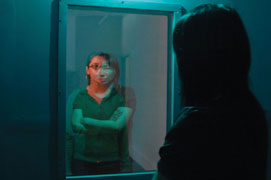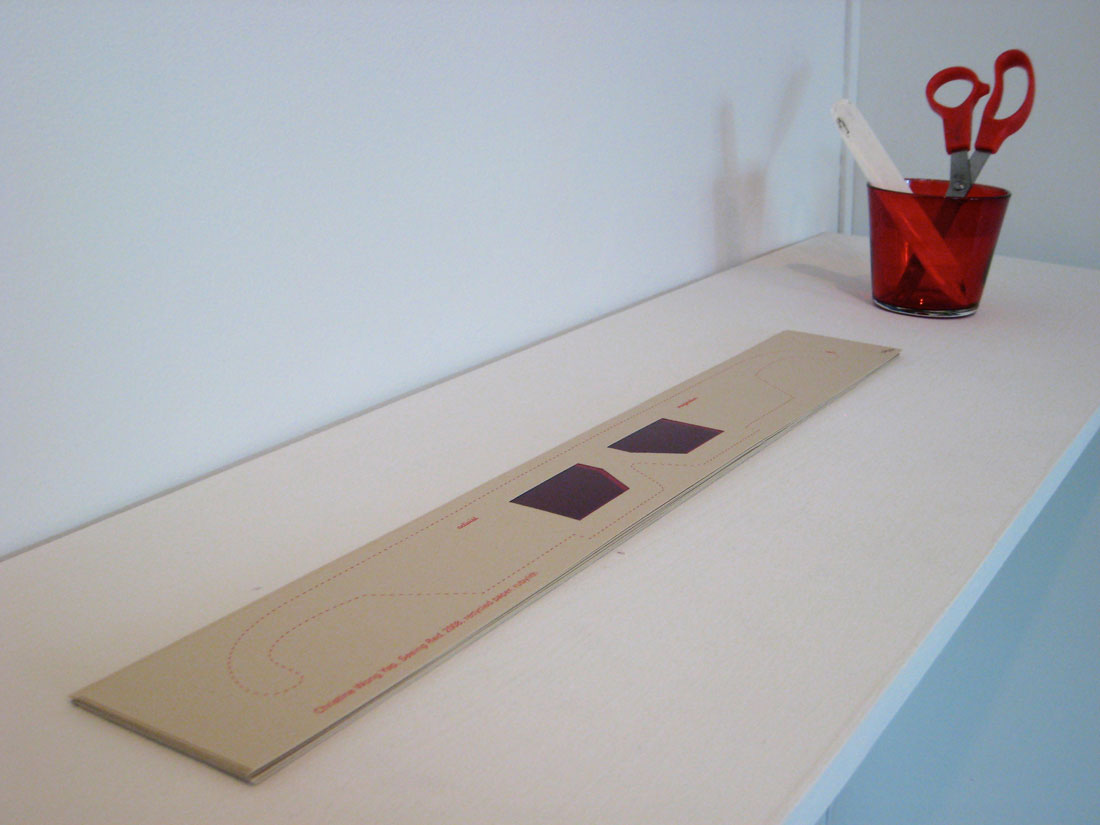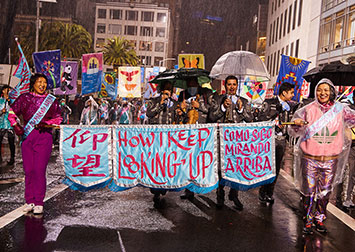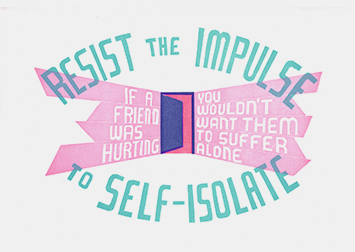Activist Imagination










Site-specific projects for Activist Imagination: The Best Person I Can Be, Untitled (windows), Seeing Red, and a curatorial project of early posters by Kearny Street Workshop artists, including Zand Gee, Nancy Hom, Jack Loo, Mitsui Murai, Leland Wong and others.

The Best Person I Can Be (exterior view), 2008,
installation: security mirrors, frame, lights, fixtures, wall, 8 x 8
x 8 feet / 2.4 x 2.4 x 2.4 m. photo: Bob Hsiang
Offers opportunities for reflection that are vulnerably optimistic (What does the best person I can be look like?) and safely pessimistic (an anti-social space for scrutiny). Attempts to make physical the act of seeing oneself reflected in other people.

The Best Person I Can Be (exterior view), 2008,
installation: security mirrors, frame, lights, fixtures, wall, 8 x 8
x 8 feet / 2.4 x 2.4 x 2.4 m. photo: Bob Hsiang
Offers opportunities for reflection that are vulnerably optimistic (What does the best person I can be look like?) and safely pessimistic (an anti-social space for scrutiny). Attempts to make physical the act of seeing oneself reflected in other people.

The Best Person I Can Be (interior view). photo: Bob Hsiang
A space for scrutiny.

The Best Person I Can Be (interior view. photo: Bob Hsiang
A space to see yourself reflected in others.

Untitled, 2008, site-specific window intervention: window film, gels, acetate, 9 x 7 feet / 2.7 x 2.1 m
Colors views of the world. The windows are mostly tinted dark, with peepholes in various colors of roses. Only one pair of peepholes is left uncolored.

detail

Seeing Red (installation view), 2008, screenprint, rubylith, 20 x 3 inches
/ 508 x 76 mm
An edition of screen-printed glasses with lenses of Rubylith, a screen-printing film. A proposal for lenses to be worn and removed. Recalls KSW’s start as a screenprint workshop, while questioning reactionary modes.

SeeingRed (glasses cut out by viewers), 2008, screenprint, rubylith, 6 x 3 x 6 inches / 152 x 76 x 156 mm

Kearny Street Workshop artists, including Zand Gee, Nancy Hom, Jack Loo, Mitsui Murai, Leland Wong and others, An exhibition of reproductions of Kearny Street Workshop Posters, curated by Christine Wong Yap, 1974–1983, digital prints, 10 x 10 x 10 feet / 3 x 3 x 3 m (installation)
Acknowledges KSW’s graphic legacy as well as my sense of chronological distance from the conditions in which KSW emerged. The informal display is inspired by the some original style, funk and utilitarianism of the posters. View the poster guide (PDF, 356 kb).

Detail. Angel Island Immigration Station woodcut and Coming Together screenprint by Leland Wong. Remaining works: artists unknown.
A series of site-specific projects considering the role of personal perspectives in the future of activism.
My contributions share the theme of perception—highlighting the lens through which one sees the world—as well as my assumptions that optimism is happy, bright, vulnerable, rare, clear, and pessimism is unhappy, dark, powerful, abundant and distorted.
To mark its 35th anniversary, Kearny Street Workshop organized Activist Imagination and asked me to envision the future of activism. Skeptical of a singular vision (even my own), I considered how activist participation is shaped by how one sees the world and ones’ reflection in the world. Whether one’s views or actions can have an impact on the world—indeed, on the future of activism—is essentially a negotiation between optimism and pessimism. I developed works to offer viewers opportunities to enact or consider their own agency.
Captions: Christine Wong Yap, The Best Person I Can Be (exterior view), 2008, installation: security mirrors, frame, lights, fixtures, wall, 8 x 8 x 8 feet / 2.4 x 2.4 x 2.4 m. photo: Bob Hsiang // Untitled, 2008, site-specific window intervention: window film, gels, acetate, 9 x 7 feet / 2.7 x 2.1 m // SeeingRed (glasses cut out by viewers), 2008, screenprint, rubylith, 6 x 3 x 6 inches / 152 x 76 x 156 mm // Kearny Street Workshop artists, including Zand Gee, Nancy Hom, Jack Loo, Mitsui Murai, Leland Wong and others, An exhibition of reproductions of Kearny Street Workshop Posters, curated by Christine Wong Yap, 1974–1983, digital prints, 10 x 10 x 10 feet / 3 x 3 x 3 m (installation)
Activist Imagination is made possible by to the support of the Creative Work Fund, the San Francisco Foundation and generous individual donors. The artist would also like to thank the California Ethnic and Multicultural Archives, Sam Chanse, Zand Gee, Nancy Hom, Leland Wong, Bob Hsiang, and Elizabeth Travelslight.











_Partner=Unfinished_Photographer=JeffScroggins_Ig@jscrogginsphoto_002-355x252.jpg)